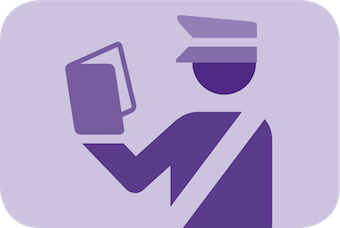Arrive and Proceed Through Customs
 When you enter a different country, you will have go through the immigration process. Each country will have its own agency that administers this inspection process. For the vast majority of passengers the immigration process only takes a few minutes, though lines can get long if many international flights arrive around the same time. Once you land, just follow the signs (and other passengers) to the immigration area.
When you enter a different country, you will have go through the immigration process. Each country will have its own agency that administers this inspection process. For the vast majority of passengers the immigration process only takes a few minutes, though lines can get long if many international flights arrive around the same time. Once you land, just follow the signs (and other passengers) to the immigration area.
Where to Go
- Upon arrival and entrance into the immigration area, passengers are split into multiple lines. There is generally a line for host country nationals (people with a passport from that country), sometimes a line for citizens of the region (EU, ECOWAS, etc), and non-immigrant visitors. Be sure to enter the correct line to avoid confusion and wasting your time and the time of the officials. When going through immigration in a country in which you are not a host-country national, you will likely go through the non-immigrant visitor line.
- Do NOT use your cell phone or camera in the immigration area. Cell phone calls are not allowed in this area and could be subject to confiscation. It is a good practice to avoid using any electronics in the immigration and inspection area.
- Stay relaxed. As long as you are honest and pay attention to instructions, there will be nothing to worry about.
Steps of the Immigration Process
1) Review Travel Documents
Officials will review your required passenger travel documents, such as passport, visa, green card, disembarkation card (provided by flight attendant during flight), immunization documentation, letters of confirmation or support, etc.
2) Questions and Processing
- Officials will likely ask you questions, as deemed necessary by the process or official. Typical questions: What is the nature of your visit? How long are you staying? Where will you be staying?
- Some countries require fingerprints and/or photos of every individual entering the the country. Officials will take fingerprints or photos if required.
- Official will stamp your passport once you are approved and granted admission.
- Officials can specify your period of authorized stay in case of non-immigrant visitors (this will depend on visa rules/tourist stay policies).
Second-Level Inspection
Some passengers might be selected for a second level of inspection. Second-level inspections could be conducted in the same queue (line) or in a separate room to aid in a conversation and to keep the queues moving for other passengers. The timeframe of these inspections can vary greatly.
Passengers that are part of second-level inspections could be granted regular admission into the country once inspection is complete. However, if the incorrect or inadequate documentation is provided, passengers can be denied approval to enter country. Passengers are sent back to their original location on the next available flight.
Reasons for second-level inspection: random checks or questions/issues with documentation.
Going Through Customs—What Does it Mean?
After clearing immigration and collecting your baggage, you will need to proceed through the customs area before being allowed to exit the airport. Customs is the authority in the respective country you enter that is responsible for controlling the flow of goods, including animals, transports, foods, personal effects, and hazardous items, into and out of a country.
- Just as each country has an agency that facilitates the immigration process, the country you enter will have its own laws and regulations regarding the import and export of goods into and out of a country. It is the responsibility of the respective customs agency to enforce these policies.
- Many countries are strict about the transfer of soil/sand/dirt from one country to another—it is important to avoid introducing non-native organisms. Certain countries will have strict rules around this transfer and may ask questions or require you to clean your shoes, clothes, and/or personal effects before clearing customs.
- For the vast majority of passengers clearing customs only takes a few minutes.
- Some countries have goods that are restricted or forbidden to be exported and/or imported.
Customs Action Steps
While on your flight, your flight attendant will distribute a Customs Declaration Form.
Most forms ask the point of exit and entry of your flight, your flight number, and what goods you may be bringing into the country (forms might list prohibited items for the respective country).
- Complete the Customs Declaration Form while on the flight.
- Ask questions to your flight attendant or traveling companions as needed.
- Declare any goods you have with you that might have restrictions, and/or goods you purchased in country when returning to your home country.
- Present your declaration form to customs officials.
- Customs officials may or may not inspect your luggage. If they do check your bags and find restricted items, you may be asked to pay duty and/or fines. This is why it is critical to declare items as asked and required.
Each country and airport will have varying processes and requirements for customs and rules around declaration of items. Review the specific country and airport of entry for specific customs guidelines.